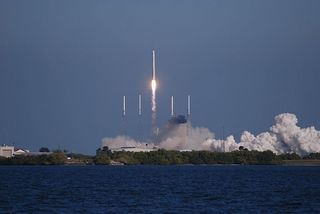
MOUNTAIN VIEW, Calif. — The search for signs of life on Mars may have just gotten a lot cheaper.
NASA is working with private spaceflight firm Space Exploration Technologies (SpaceX) to plan a mission that would search for evidence of life buried in the Martian dirt. The NASA science hardware would fly to the Red Planet aboard SpaceX's Dragon capsule, which the company is developing to ferry cargo and astronauts to and from the International Space Station.
This so-called "Red Dragon" mission, which could be ready to launch by 2018, would carry a cost of about $400 million or less, researchers said.
"I just want a cheap delivery system to go to Mars," said astrobiologist Chris McKay, of NASA's Ames Research Center here. "I don't care how it gets there." [The Falcon and Dragons of SpaceX]
Mission to Mars
The mission doesn't have an official name, McKay said. "Red Dragon" is just what he has been calling it informally.
McKay and his colleagues are developing the Red Dragon concept as a potential NASA Discovery mission, a category that stresses exploration on the relative cheap. NASA is currently vetting three Discovery candidates, one of which it will choose for a 2016 launch. That mission will be cost-capped at $425 million, not including the launch vehicle.
Get the Space.com Newsletter
Breaking space news, the latest updates on rocket launches, skywatching events and more!
Red Dragon is not in that group of three finalists. NASA will make another call for Discovery proposals in 18 months or so, McKay said, and he and his team plan to be ready for that one. If Red Dragon is selected in that round, it could launch toward Mars in 2018.
Assuming that $425 million cap is still in place, Red Dragon could come in significantly under the bar.
"We'd have money left over to do some science," McKay told SPACE.com here Saturday (July 30) during the NewSpace 2011 conference, which was held at NASA Ames. "Wouldn't that be great?"
Drilling into the ice
Red Dragon wouldn't be the next Mars surface mission.
NASA is currently gearing up to send a car-size rover called Curiosity to Mars as the centerpiece of the agency's $2.5 billion Mars Science Laboratory (MSL) mission. MSL is slated to launch this November and arrive at the Red Planet in August 2012.
Curiosity will use a suite of 10 sophisticated instruments to assess whether Mars is, or ever was, capable of supporting life. Red Dragon, on the other hand, would actually look for evidence of that life. [5 Bold Claims of Alien Life]
"We'd try to detect molecules that are proof of life, like DNA or perchlorate reductase," McKay said. "That's what we'd be searching for — proof of life through biomolecules."
The Martian surface today is bone-dry and bombarded by damaging ultraviolet radiation, making life unlikely to survive there. But Red Dragon would drill 3.3 feet (1 meter) or so underground, in an effort to sample reservoirs of water ice known to lurk under the red dirt.
Researchers are looking at two possible Martian sites for Red Dragon's mission, McKay said. One is the landing site of NASA's Phoenix lander; the other is where NASA's Viking 2 lander touched down in 1976. Both areas are known to harbor subsurface ice. [Infographic: Mars Landers and Rovers Since 1971]
Partnering with private spaceflight

SpaceX is developing the Dragon capsule under a NASA contract to resupply the International Space Station. The company also hopes NASA will use a human-rated version of Dragon to ferry astronauts to and from the orbiting lab, perhaps by 2015 or so.
But SpaceX has bigger dreams. Earlier this year, for example, CEO Elon Musk announced that the company hopes to send an astronaut to Mars within the next 10 to 20 years. That would beat NASA's timeline; the space agency has tentative plans to put boots on the Red Planet by the mid-2030s.
SpaceX is developing a heavy-lift rocket, called the Falcon Heavy, which could carry Dragon to Mars. The Falcon Heavy may launch for the first time by late 2012 or early 2013, Musk has said.
So using Dragon as a payload delivery system to Mars lines up with SpaceX's ambitious long-term plans. Indeed, Musk has noted Dragon's potential to aid exploration missions to other worlds.
"This would possibly be several tons of payload — actually, a single Dragon mission could land with more payload than has been delivered to Mars cumulatively in history," Musk told MSNBC's Alan Boyle recently.
And as the capabilities of private spaceflight firms like SpaceX improve, relying on them to carry hardware to other planets could make more and more economic sense for scientists like himself, McKay said.
"I want the commercial space sector to drive costs down," he said. He added, by way of analogy: "When I go on scientific expeditions to the polar regions [of Earth], I don't build a helicopter from scratch."
You can follow SPACE.com senior writer Mike Wall on Twitter: @michaeldwall. Follow SPACE.com for the latest in space science and exploration news on Twitter @Spacedotcom and on Facebook.
Join our Space Forums to keep talking space on the latest missions, night sky and more! And if you have a news tip, correction or comment, let us know at: community@space.com.

Michael Wall is a Senior Space Writer with Space.com and joined the team in 2010. He primarily covers exoplanets, spaceflight and military space, but has been known to dabble in the space art beat. His book about the search for alien life, "Out There," was published on Nov. 13, 2018. Before becoming a science writer, Michael worked as a herpetologist and wildlife biologist. He has a Ph.D. in evolutionary biology from the University of Sydney, Australia, a bachelor's degree from the University of Arizona, and a graduate certificate in science writing from the University of California, Santa Cruz. To find out what his latest project is, you can follow Michael on Twitter.
